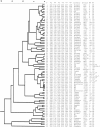Development of multiple-locus variable-number tandem-repeat analysis for Yersinia enterocolitica subsp. palearctica and its application to bioserogroup 4/O3 subtyping
- PMID: 17553973
- PMCID: PMC1951228
- DOI: 10.1128/JCM.02252-06
Development of multiple-locus variable-number tandem-repeat analysis for Yersinia enterocolitica subsp. palearctica and its application to bioserogroup 4/O3 subtyping
Abstract
Yersinia enterocolitica bioserogroup 4/O3 is the predominant causative agent of yersiniosis in Europe and North America. Multiple-locus variable-number tandem-repeat analysis (MLVA) was developed to improve the resolution power of classical genotyping methods. MLVA based on six loci was able to distinguish 76 genotypes among 91 Y. enterocolitica isolates of worldwide origin and 41 genotypes among 51 nonepidemiologically linked bioserogroup 4/O3 isolates, proving that it has a high resolution power. However, only a slight correlation of the MLVA genotypes and the geographic distribution of the isolates was observed. Although MLVA was also capable of distinguishing strains of Y. enterocolitica subsp. palearctica O9 and O5,27, there was only a minor correlation between the MLVA genotypes and serogroups. MLVA may be a helpful tool for epidemiological investigations of Y. enterocolitica subsp. palearctica outbreaks.
Figures


References
-
- Benito, I., M. E. Cano, J. Aguero, and J. M. G. Lobo. 2004. A polymorphic tandem repeat potentially useful for typing in the chromosome of Yersinia enterocolitica. Microbiology 150:199-204. - PubMed
Publication types
MeSH terms
Substances
LinkOut - more resources
Full Text Sources

